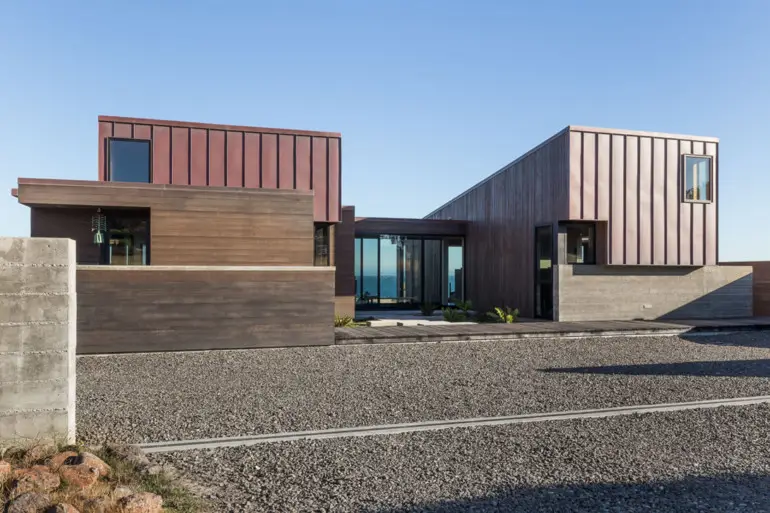A pair of modernists live in harmony with nature in Sonoma County.
“OUR NORTHERN CALIFORNIA summer home represents notions of sustainability and biophilic design,” says Erich Burkhart, a principal at Perkins Eastman, an architecture firm that specializes in residential towers and large medical centers. “But it is also a unique personal expression.”
It is certainly one of the newest and most individualistic designs at Sea Ranch, the 1960s residential enclave that spreads over 10 miles of oceanfront property in Sonoma County, two hours north of San Francisco.
The back-to-nature community has small, rugged, no-nonsense woodclad buildings designed in a modern barn vernacular by late Bay Area architects Charles Moore and Bill Turnbull of MLTW, as well as architect Joseph Esherick and landscape architect Lawrence Halprin, who created the master plan.

If Sea Ranch’s strict regulations for building size and use of local materials seem restrictive for some, Burkhart and his husband, architect Doug Hudson, who specializes in similar projects in their home base of Palm Springs, welcomed them.
Yielding to Sea Ranch neighbors who did not want their ocean views obstructed by a bar-shaped building on the bluff, the couple created one that appears instead to be composed of three parallel copper- and cedar clad shipping containers, set sufficiently apart to form view corridors; their shed roofs of standing seam copper slope southward, toward the Pacific.
The west pavilion, containing the master suite and another bedroom, and the central pavilion, which contains living spaces, are linked by a covered see-through glass-walled bridge; the stand-alone east pavilion contains the guest suite and a garage. Ranged around a gravel-filled courtyard, they are all connected by an east-west boardwalk and surrounded by low board-formed concrete fencing.
Viewed from the south, the wedge-shaped pavilions appear less fortified, with gleaming walls of glass that face expansive skies and the ocean.
“At Sea Ranch, we have a well-defined architectural history going back to the work of MLTW, Esherick and Halprin, inspired by a great vocabulary of simple agricultural precedents in the county: simple shed roofs, barn doors, and the use of wood are everywhere,” Burkhart says. “We worked to integrate that vocabulary in a new building that is meshed into the landscape.”

Thus Burkhart and Hudson’s sloped roofs echo the angle of the site, and because the home is broken into separate pavilions, it can be interspersed with drought-resistant landscaping; the meadow also emerges between pavilions.
Nature contributes in other ways too. In the two winters since they finished the house, the cedar siding has developed a mottled patina; the shiny copper roof and walls have mellowed to a reddish purple and will eventually turn grayish green.
Inside, with project architect Bob Hartstock, the owners tried to maximize space. “The highest point of the roof could only be 16 feet above grade, so we lowered the living room floor to match the sloping site; now the room is 18.5 feet high,” Burkhart says. And if the unfinished cedar clad ceiling and walls above an 8-foot datum line look like inverted rafts floating over white plasterboard walls, it is no coincidence. Burkhart’s father, a naval physician, used to work on nuclear submarines that took them to world ports. “We definitely used nautical cues in the design,” Burkhart says. “Pocket doors use less space; we gave rooms and cabinetry multiple functions; things were built into voids of walls, like bookcases and cabinets; window seats cantilever out toward the ocean. The scale is modest and yet the perception is that of a big house.”

To match the exterior palette, floors with radiant heat are of troweled concrete; some exterior board-formed concrete walls, also visible inside, have no other finish. “Fewer materials and fewer trades kept costs just under $600 a square foot,” Burkhart says.
“I concentrated on varying the interior palette,” Hudson adds. “Instead of predictable furniture such as a black Corbusier sofa, which can be stiff, I looked for practicality and comfort.”
In that vein, he picked weather-resistant bronze finishes for aluminum Fleetwood windows; unexpected dark textured Ann Sacks concrete tiles for the master bath; earthy dark-brown solid Corian countertops; and blackened steel cladding for the wood-burning stove in the living room.
The natural fabrics and carpets he chose help soften the interior. Cherished Domestic bedroom furniture by artist Roy McMakin, which the pair acquired during the 1980s in Los Angeles, suits the spare spaces filled with wool rugs specially designed for them by Angela Adams, their longtime favorite from Portland, Maine.

There are other old standards, including Mario Bellini leather dining chairs that they also chose for their home in Palm Springs. “When we have only one house, we will consolidate them,” Hudson says.
Selecting art for the limited wall space required collaborative planning. But “after 35 years together, we have similar eclectic tastes,” Hudson says.
A wood sculpture in the foyer looks vaguely Mayan from a distance. Up close, it is an intriguing collage of heads and limbs. A painting of a submarine dominates the living room, as a nod to Burkhart’s father’s naval past. In the guest space, a sepia-tinted work on vellum shows illustrations of two boys from a 1950s Red Cross first aid manual. On the opposite wall are tantric images from India. “They are 100 years old but look so contemporary,” Hudson says.
Art is great, but for Burkhart there is no greater thrill than looking up from a book when he is in one of the window seats and suddenly seeing deer, kit foxes, bobcats or birds pass by the big windows. “I also find the most spectacular time to be here is during winter storms,” he adds. “Waves crash over the cliff and they seem to shake the entire house.” In fact, he’s tempted to make Sea Ranch their winter retreat. “I love storm-watching. It is like being at sea without getting seasick.”

